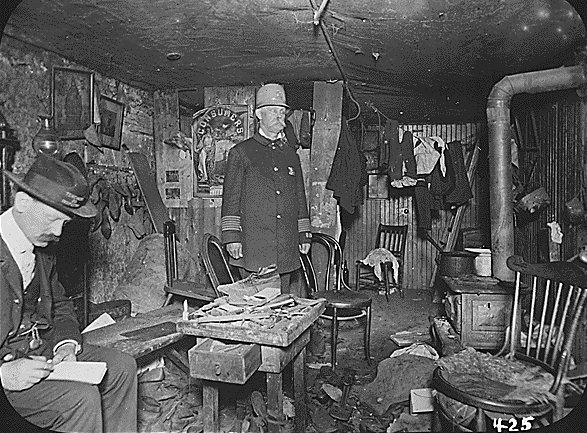
Throughout the Famine years, nearly a million Irish arrived in the United States. Famine immigrants were the first big wave of poor refugees ever to arrive in the U.S. and Americans were simply overwhelmed. Upon arrival in America, the Irish found the going to be quite tough. With no one to help them, they immediately settled into the lowest rung of society and waged a daily battle for survival.In New York, officials investigate a squalid tenement, 1900.The roughest welcome of all would be in Boston, Massachusetts, an Anglo-Saxon city with a population of about 115,000. It was a place run by descendants of English Puritans, men who could proudly recite their lineage back to 1620 and the Mayflower ship. Now, some two hundred thirty years later, their city was undergoing nothing short of an unwanted “social revolution” as described by Ephraim Peabody, member of an old Yankee family. In 1847, the first big year of Famine emigration, the city was swamped with 37,000 Irish Catholics arriving by sea and land.Proper Bostonians pointed and laughed at the first Irish immigrants stepping off ships wearing clothes twenty years out of fashion. They watched as the newly arrived Irishmen settled with their families into enclaves that became exclusively Irish near the Boston waterfront along Batterymarch and Broad Streets, then in the North End section and in East Boston. Irishmen took any unskilled jobs they could find such as cleaning yards and stables, unloading ships, and pushing carts.
There was little Italian emigration to the United States before 1870. However, Italy was now one of the most overcrowded countries in Europe and many began to consider the possibility of leaving Italy to escape low wages and high taxes. Most of these immigrants were from rural communities with very little education. From 1890 to 1900, 655,888 arrived in the United States, of whom two-thirds were men. A survey carried out that most planned to return once they had built up some capital.
Most Italians found unskilled work in America’s cities. There were large colonies in New York, Philadelphia, Chicago,Baltimore and Detroit. From 1900 to 1910 over 2,100,00 arrived. Of these, around 40 per cent eventually returned to Italy.
Willing to work long hours on low wages, the Italians now began to rival the Irish for much of the unskilled work available in industrial areas. This sometimes led to hostilities breaking out between the two groups of workers. The Italians were also recruited into the garment industry and by the outbreak of the First World War had replaced theJews as the main group in the sweated trades.
After the First World War Italians developed a reputation for becoming criminals. This was mainly due to high-profile criminals such as Al Capone, Lucky Luciano, Joe Masseria, Albert Anastasia, Salvadore Marazano, Vito Genoveseand Frank Costello. However, a study in Massachusetts revealed that the Italian-born, who comprised 8.0 per cent of the population of the state, made up only 4.2 per cent of those confined in penal institutions. The US Department of Justice also estimates that less than .0025 percent of Italian Americans have anything to do with organized crime.
Prejudice against Italians and anarchists contributed to the false conviction of Nicola Sacco and Bartolomeo Vanzettiin 1921.
Italians also became active in trade unions and produced several leaders such as Arthuro Giovannitti and Carlo Tresca. Second-generation Italians became important figures in progressive politics. This included figures such asFiorello LaGuardia, Vito Marcantonio, and Emmanuel Celler.
During the period 1820 and 1920 over 4,190,000 people emigrated from Italy to the United States. Only Ireland(4,400,000) and Germany (5,500,000) came anywhere near these figures.MORE
The slumdogs of New York: Remarkable images open a window into the squalor and deprivation endured by immigrant families in an unrecognisable 19th century America (thank you Dirkster and battleskin88 )
It is a window into the squalor, deprivation and poverty of a bygone age.
This city of sweat shops, shanty towns and slums is an unrecognisable New York, captured, in black and white, as the 19th century wound to a close.
Newly arrived immigrants slept 12 to a room, while street children roamed the alleys and tenement blocks of a Third World downtown Manhattan.
Short URL: http://www.newsnet14.com/?p=93353















No comments:
Post a Comment